Related Research Articles
CIA cryptonyms are code names or code words used by the U.S. Central Intelligence Agency (CIA) to refer to projects, operations, persons, agencies, etc.

The Defense Intelligence Agency (DIA) is an intelligence agency and combat support agency of the United States Department of Defense, specializing in defense and military intelligence.

Robert Philip Hanssen was an American Federal Bureau of Investigation (FBI) agent who spied for Soviet and Russian intelligence services against the United States from 1979 to 2001. His espionage was described by the Department of Justice as "possibly the worst intelligence disaster in U.S. history".
The Farewell Dossier was the collection of documents that Colonel Vladimir Vetrov, a KGB defector "en place", gathered and gave to the Direction de la surveillance du territoire (DST) in 1981–82, during the Cold War.
The Vela incident was an unidentified double flash of light detected by an American Vela Hotel satellite on 22 September 1979 near the South African territory of Prince Edward Islands in the Indian Ocean, roughly midway between Africa and Antarctica. Today, most independent researchers believe that the flash was caused by a nuclear explosion—an undeclared joint nuclear test carried out by South Africa and Israel.

The State Intelligence Agency, commonly referred to as BIN, is Indonesia's primary intelligence agency. The BIN is responsible for coordinating information sharing and information gathering operations with other Indonesian intelligence agencies, as well as conducting independent operations.

Military animals are trained animals that are used in warfare and other combat related activities. As working animals, different military animals serve different functions. Horses, elephants, camels, and other animals have been used for both transportation and mounted attack. Pigeons were used for communication and photographic espionage. Many other animals have been reportedly used in various specialized military functions, including rats and pigs. Dogs have long been employed in a wide variety of military purposes, more recently focusing on guarding and bomb detection, and along with dolphins and sea lions are in active use today.

Edward Lee Victor Howard was a CIA case officer who defected to the Soviet Union.

The Central Intelligence Agency, known informally as the Agency and historically as the Company, is a civilian foreign intelligence service of the federal government of the United States, officially tasked with gathering, processing, and analyzing national security information from around the world, primarily through the use of human intelligence (HUMINT) and conducting covert action through its Directorate of Operations. As a principal member of the United States Intelligence Community (IC), the CIA reports to the Director of National Intelligence and is primarily focused on providing intelligence for the President and Cabinet of the United States. Following the dissolution of the Office of Strategic Services (OSS) at the end of World War II, President Harry S. Truman created the Central Intelligence Group under the direction of a Director of Central Intelligence by presidential directive on January 22, 1946, and this group was transformed into the Central Intelligence Agency by implementation of the National Security Act of 1947.
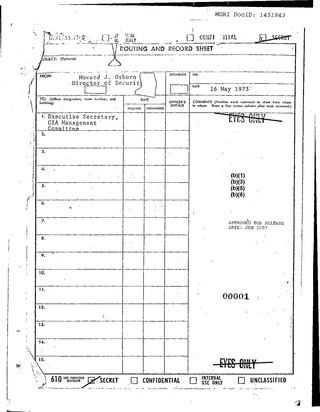
The "Family Jewels" is the name of a set of reports detailing illegal, inappropriate and otherwise sensitive activities conducted by the Central Intelligence Agency from 1959 to 1973. William Colby, the CIA director who received the reports, dubbed them the "skeletons in the CIA's closet". Most of the documents were released on June 25, 2007, after more than three decades of secrecy. The non-governmental National Security Archive filed a request for the documents under the Freedom of Information Act fifteen years before their release.

The Directorate of Science & Technology (DS&T) is the branch of the United States Central Intelligence Agency (CIA) tasked with collecting and analyzing information through technological means and developing technical systems in order to advance the CIA’s intelligence gathering.
Victor Leo Marchetti Jr. was a special assistant to the Deputy Director of the Central Intelligence Agency who later became a prominent critic of the United States Intelligence Community and the Israel lobby in the United States.
Vincent Cannistraro was Director of Intelligence Programs for the United States National Security Council (NSC) from 1984 to 1987; Special assistant for Intelligence in the Office of the Secretary of Defense until 1988; and Chief of Operations and Analysis at the Central Intelligence Agency's (CIA) Counterterrorist Center until 1991.
The Afghanistan conflict began in 1978 and has coincided with several notable operations by the United States (U.S.) Central Intelligence Agency (CIA). The first operation, code-named Operation Cyclone, began in mid-1979, during the Presidency of Jimmy Carter. It financed and eventually supplied weapons to the anti-communist mujahideen guerrillas in Afghanistan following an April 1978 coup by the People's Democratic Party of Afghanistan (PDPA) and throughout the nearly ten-year military occupation of Afghanistan by the Soviet Union (U.S.S.R.). Carter's successor, Ronald Reagan, supported an expansion of the Reagan Doctrine, which aided the mujahideen along with several other anti-Soviet resistance movements around the world.
At various times since the creation of the Central Intelligence Agency, the Federal government of the United States has produced comprehensive reports on CIA actions that marked historical watersheds in how CIA went about trying to fulfill its vague charter purposes from 1947. These reports were the result of internal or presidential studies, external investigations by congressional committees or other arms of the Federal government of the United States, or even the simple releases and declassification of large quantities of documents by the CIA.
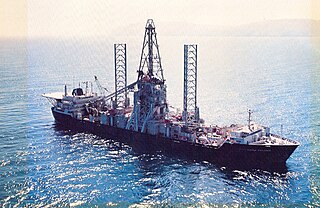
Project Azorian was a U.S. Central Intelligence Agency (CIA) project to recover the sunken Soviet submarine K-129 from the Pacific Ocean floor in 1974 using the purpose-built ship Hughes Glomar Explorer. The 1968 sinking of K-129 occurred approximately 1,600 miles (2,600 km) northwest of Hawaii. Project Azorian was one of the most complex, expensive, and secretive intelligence operations of the Cold War at a cost of about $800 million, or $4.7 billion today.
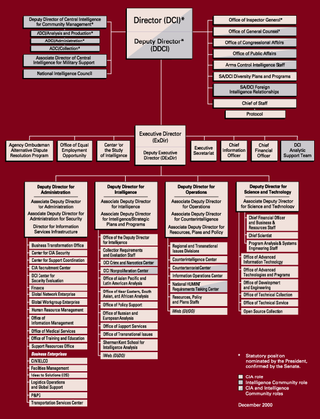
The CIA publishes organizational charts of its agency. Here are a few examples.
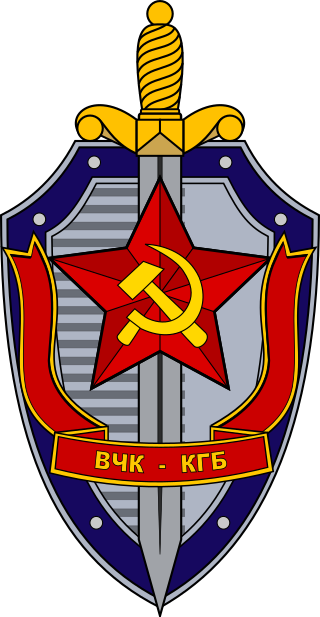
The Committee for State Security (CSS) was the main security agency for the Soviet Union from 13 March 1954 until 3 December 1991. As a direct successor of preceding agencies such as the Cheka, GPU, OGPU, NKGB, NKVD and MGB, it was attached to the Council of Ministers. It was the chief government agency of "union-republican jurisdiction", carrying out internal security, foreign intelligence, counter-intelligence and secret police functions. Similar agencies operated in each of the republics of the Soviet Union aside from the Russian SFSR, where the KGB was headquartered, with many associated ministries, state committees and state commissions.

The Pinochet File is a National Security Archive book written by Peter Kornbluh covering over approximately two decades of declassified documents, from the Central Intelligence Agency (CIA), Defense Intelligence Agency (DIA), White House, and United States Department of State, regarding American covert activities in Chile. It is based on more than 24,000 previously classified documents that were released as part of the Chilean Declassification Project during the Clinton administration, between June 1999 and June 2000.
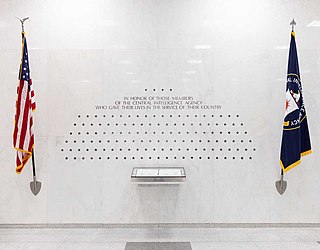
The United States Central Intelligence Agency (CIA) dates from September 18, 1947, when President Harry S. Truman signed the National Security Act of 1947 into law. A major impetus that has been cited over the years for the creation of the CIA was the unforeseen attack on Pearl Harbor, but whatever Pearl Harbor's role, at the close of World War II government circles identified a need for a group to coordinate government intelligence efforts, and the Federal Bureau of Investigation (FBI), the State Department, the War Department, and even the Post Office were all jockeying for that new power.
References
- 1 2 3 4 Donald, Graeme (2011). Loose Cannons: 101 Myths, Mishaps and Misadventurers of Military History. Osprey Publishing. ISBN 978-1-84908-651-6.
- ↑ Anthes, Emily (2013). Frankenstein's cat : cuddling up to biotech's brave new beasts (First ed.). New York: Scientific American / Farrar, Straus and Giroux. ISBN 978-0-374-15859-0.
- ↑ "Cat was walking bug". Herald Sun. November 5, 2001.
- ↑ Curtis, Adam, "You Have Used Me as a Fish Long Enough", The Living Dead , BBC television documentary, 1995, interview with Victor Marchetti at 28:10
- ↑ TV series "The World's Weirdest Weapons", season 1, episode 6: "Weapons Of The Superspies", Yesterday TV
- ↑ Jeffrey T. Richelson, The Wizards of Langley: Inside the CIA's Directorate of Science and Technology (Boulder, CO: Westview Press, 2002), 147-48. ISBN 0-8133-4059-4.
- ↑ Vnederbilt, Tom (October 2013). "The CIA's Most Highly-Trained Spies Weren't Even Human". Smithsonian Magazine. Washington, DC: Smithsonian Institution. Archived from the original on 1 November 2019. Retrieved 31 October 2018.
- ↑ U.S. Central Intelligence Agency (March 1967). "Views on Trained Cats Use" (PDF). George Washington University. Archived (PDF) from the original on June 17, 2014. Retrieved March 21, 2014., redacted (pdf)
- ↑ Julian Borger (September 11, 2001). "Project: Acoustic Kitty". The Guardian Newspaper. Archived from the original on May 26, 2020. Retrieved December 10, 2016.